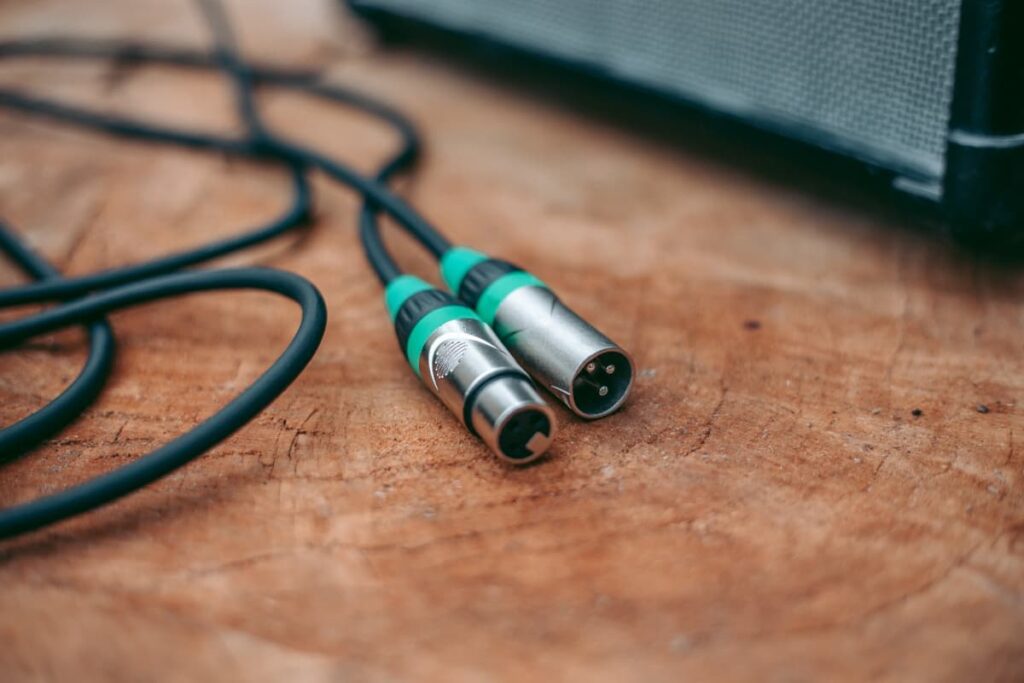Home recording studios have become increasingly popular in recent years, and one of the most important pieces of gear is a good set of XLR cables. These cables connect microphones to audio interfaces, amplifiers, audio mixers, and other devices. But are all XLR cables the same size?
Not all XLR cables are the same size. There are a variety of XLR cable sizes available on the market today. The size of an XLR cable is typically indicated by the thickness of the wire and overall quality. The sizes range from standard connectors to smaller XLR connectors.

Table of Contents
- Regular and Mini XLR Microphone Cables
- What are the Differences Between Standard and Mini Cables?
- Which One Is Right for Me?
- Final Thoughts on XLR Cable Sizes
In this article, I’ll go into more detail about the different types of XLR cables, their differences, and what you should look for when choosing the right XLR microphone cable for your home recording studio.
Regular and Mini XLR Microphone Cables
Recording studios typically use two types of XLR3 cables: regular-sized and mini. These are typically three-pin connectors that you can use to connect microphones to other audio devices, hence the name XLR3.
Standard XLR Cables
Regular-sized XLR cables are the most commonly used XLR cables with professional audio equipment.
The connectors on these microphone cables are standard, and the wires are thicker or have a higher gauge.
The main benefit of using regular-sized XLR cables is that you can use them with a wider range of audio equipment.
The connectors on these cables are standard size so they will fit into most audio interfaces and other devices.
Another benefit of using regular-sized XLR cables is that they are less likely to come loose than mini XLR cables.
The connectors on these cables are larger and more secure, so they are less likely to come loose during a recording session.
Small XLR Cables
Mini XLR cables are becoming more popular in recording studios due to their compact size. These mic cables have mini XLR connectors about half the size of regular XLR connectors.
One of the main benefits of using mini XLR cables is that they are more versatile. The compact size of these cables makes them ideal for use with portable recording devices and other small audio interfaces.
Moreover, the smaller size of these mic cables allows for a more efficient setup and reduced clutter in the studio.
However, the smaller XLR connectors on mini XLR cables mean you can only use these mic cables with a limited number of audio devices.
Male XLR connectors vs Female XLR connectors
The two kinds available include male, female, and male-female connector combinations. Standard connectors are male and have hollow ends that are adapted for females.
Generally, these are color-coded: red to be positive (+), black to be negative (+). Always get the cables specifically designed for your device plug because they vary a bit by the manufacturer.
The extension between male and female cable extensions for long cables will keep the audio signal stable. If the distance is more than 30 meters, you need either a transformer or two that match the impedance of your cable.
What are the Differences Between Standard and Mini Cables?
The primary differences between standard and mini cables are quality, gauge, and overall size. Length and price are also determining factors. Higher quality cables tend to be of standard size.
Now that you know the two main types of XLR cables let’s look in more detail at the differences between them.
Quality
The biggest difference between XLR cables is the build quality. XLR cables made with higher quality materials result in more durable cables and lower resistance.
High-quality materials also enhance the cable’s flexibility, making it less likely to suffer from interference.
Wire Thickness
The gauge, or thickness, is another difference between XLR cables. The gauge of the wire affects the durability of the XLR cable.
Thicker wires make these cables more durable due to the quality of materials used.
However, thicker XLR cables are more expensive than their thinner counterparts.
Size of XLR Connectors
As I mentioned, XLR cables come with either regular-sized or mini XLR connectors. The connectors on regular XLR cables are standard-sized, while the connectors on mini XLR cables are about half the size.
The size of the XLR connector determines what type of audio equipment you can use with the cable.
For example, you can only use mini XLR cables with a limited number of audio devices due to the small size of the XLR connectors.
Cable Shielding
Cable shielding protects the wires from interference, which can cause noise in the audio signal. The type of cable shield used on an XLR cable will determine the quality of the audio signal.
There are three types of shielding that are commonly used on XLR cables:
- Braided shielding: This type of shielding is made with woven copper mesh from flat copper strands that surrounds the inner wires. This type of braided copper shielding is very effective at reducing interference and durability.
- Serve shielding: Serve shielding is made with a copper spiral that surrounds the inner wires. This type of shielding is less effective than braided shielding but is more flexible.
- Foil shielding: Foil shielding is made with a thin layer of aluminum foil and copper drain wire. This shielding is less effective than serve shielding but is more affordable.
Braided type of shielding is often used on high-end XLR cables in professional recording studios. Serve shielding is often used on mid-priced XLR cables, while foil shielding is often used on low-end XLR cables.
Length of the XLR Cable
XLR cables are available in a variety of different lengths. The length of the mic cable you need depends on the distance between your audio equipment and the power source.
The length of the mic cable may affect sound quality. The longer the cable, the more likely it is to suffer from interference. Properly designed XLR cables can minimize interference and maximize balanced audio quality and sound quality.
Price
The price of XLR cables can vary depending on different factors, such as the length of the cable, the gauge of the wire, and the type of XLR connectors.
Thicker cables do tend to be more expensive than their thinner counterparts, and length is also often a factor.
Which One Is Right for Me?
The type of XLR cable you choose does not matter as long as it meets the requirements of your audio equipment. Both cables are designed to transfer audio signals with no loss in quality.
However, if you use a small audio interface or portable recording device, you may need a mini XLR cable. The smaller size of these microphone cables makes them more versatile and easier to work with in tight spaces.
If you are using a large audio mixer or other professional-grade audio equipment, you will probably need to use a regular XLR cable.
Final Thoughts on XLR Cable Sizes
Both regular-sized and mini XLR cables are designed to transfer audio signals with no loss in quality.
The type of XLR microphone cable you choose does not matter as long as it meets the requirements of your audio equipment.
Generally, the thickness of the wire is not a major concern for most home recording studios. However, if you are using your XLR cables in a live setting, you may consider using regular-sized XLR cables due to their durability.
- Review of the ALABS IRON MINI-WL: A Powerhouse Wireless Microphone - October 4, 2023
- What is a Saturator in Music Production: A Brief Explanation - May 11, 2023
- What Are Rotary DJ Mixers? An Overview - May 11, 2023
SoundStudiomagic.com is a participant in the Amazon Services LLC Associates Program, an affiliate advertising program designed to provide a means for sites to earn advertising fees by advertising and linking to Amazon.com. We also participate in other affiliate programs which compensate us for referring traffic.

